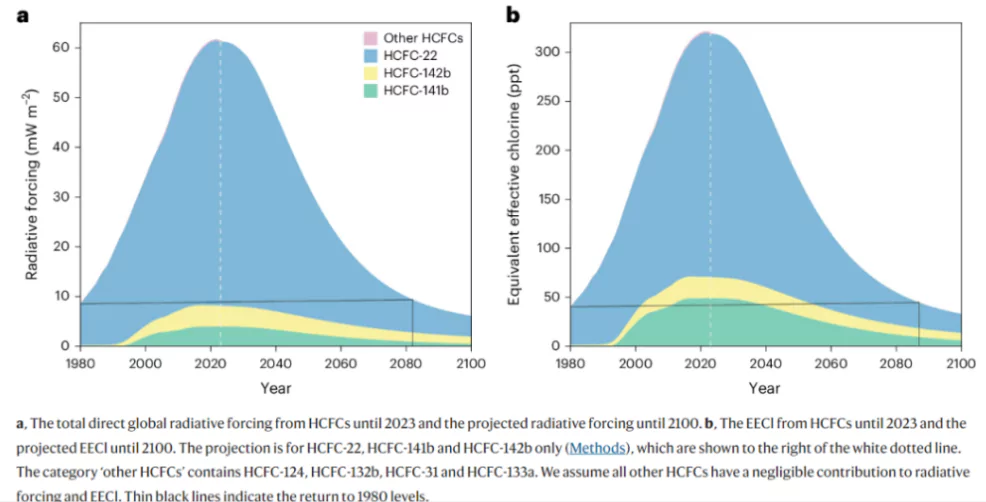A new study published in the journal Nature Climate Change reported a significant decrease in atmospheric hydrochlorofluorocarbons (HCFCs) five years before the target year.
Key Findings of the Study On Ozone-depleting HCFCs
The study is titled as “A decrease in radiative forcing and equivalent effective chlorine from hydrochlorofluorocarbons”
- Peaking of Emissions: HCFC emissions peaked in 2021, five years earlier than anticipated in 2026.
 Impact of HCFCs: Their impact on the Earth’s energy balance (known as radiative forcing) and the amount of chlorine in the atmosphere (called equivalent effective chlorine) have decreased since 2021, five years earlier than expected.
Impact of HCFCs: Their impact on the Earth’s energy balance (known as radiative forcing) and the amount of chlorine in the atmosphere (called equivalent effective chlorine) have decreased since 2021, five years earlier than expected.-
- The global direct radiative forcing from HCFCs: It decreased to 61.28 milliWatt per square metre (mW m−2) in 2023 down from 61.67 mW m−2 in 2022.
- The equivalent effective chlorine (EECl) of HCFCs decreased to 319.33 one part per trillion (ppt) in 2023 from 321.35 ppt in 2022.
- Future Projection: The HCFCs will return to their 1980 values in 2082 for radiative forcing and in 2087 for the EECI, as projected by the research.
- HCFC-22: It is the most abundant HCFC in the atmosphere with a global warming potential 1,910 times that of carbon dioxide on a 100 year time horizon. It has witnessed the most significant decline resulting in a drop in the radiative forcing and EECI between 2021 and 2023.
- HCFC-22 usage: It is used as a refrigerant in a variety of applications, including unitary air conditioners, cold storage, retail food refrigeration, chillers, and industrial process refrigeration.
Enroll now for UPSC Online Course
Hydrochlorofluorocarbons (HCFCs)
HCFCs are compounds containing carbon, hydrogen, chlorine and fluorine and are viewed as acceptable temporary alternatives to chlorofluorocarbons.
- The HCFCs have shorter atmospheric lifetimes than CFCs and deliver less reactive chlorine to the stratosphere where the “ozone layer” is found.
- Application: They are used in the foam, refrigeration, and air conditioning sectors
- International Legislation: It mandates production caps for HCFCs; production is prohibited after 2020 in developed countries and 2030 in developing countries.
|
- Other HCFCs: A minor decline was also observed in HCFC-141b (the second most abundant) from 24.63 ppt in 2022 to 24.51 ppt in 2023.
- The third most prevalent, HCFC-142b, has been progressively declining since 2017.
- India is ahead of eliminating HCFCs in new equipment manufacturing, as claimed by the government in a report released during the COP28 to UNFCCC held in Dubai 2023.
- The Role of Montreal Protocol in curbing HCFC emissions.
- The Copenhagen (1992) and Beijing (1999) Amendments to the Montreal Protocol mandates the phase-out of HCFC production and usage.
- Phase out Target: The production of HCFCs is currently being phased out globally, with a completion date slated for 2040.
- Role: The Montreal Protocol enforced strict controls and promoted the adoption of ozone-friendly alternatives, curbing the release and levels of HCFCs into the atmosphere.
Check Out UPSC CSE Books From PW Store
Global-Warming Potential (GWP)
- GWP is a term used to describe the relative potency, molecule for molecule, of a greenhouse gas, taking account of how long it remains active in the atmosphere.
- Objective: The measure was developed to allow comparisons of the global warming impacts of different gases. The larger the GWP of a gas, the more it warms the Earth as compared to CO2 over that time period
- Specifically, it is a measure of how much energy the emissions of 1 ton of a gas will absorb over a given period of time, relative to the emissions of 1 ton of carbon dioxide (CO2).
- The global-warming potentials (GWPs) are calculated over 100 years.
- Carbon dioxide is taken as the gas of reference and given a 100-year GWP of 1.
- Significance: GWPs provide a common unit of measure, which allows analysts to add up emissions estimates of different gases (e.g., to compile a national GHG inventory), and allows policymakers to compare emissions reduction opportunities across sectors and gases.
|
The Montreal Protocol
- About: It was signed in 1987 and is a global agreement to protect the stratospheric ozone layer by phasing out the production and consumption of ozone-depleting substances (ODS) by eliminating the production and consumption of ODSs like chlorofluorocarbons (CFCs) and halons.
- ODS are substances commonly used in products such as refrigerators, air conditioners, fire extinguishers, and aerosols.
- The worldwide production of CFCs has been prohibited since 2010.
- HCFCs were a replacement of CFCs but they were found to have a strong greenhouse gas potential and an ODSs.
- Hydrofluorocarbons (HFC): They have become a substitute for HCFCs. They are non-ozone depleting substances (ODS), but have high Global Warming Potential (GWP)
- The Kigali Amendment to Montreal Protocol 2016: It introduces strict restrictions on the manufacture and consumption of HFCs.
- Global Cooling Pledge and the Paris Agreement: Pledges have been made to cut HFC emissions, whose radiative force impact is rising in spite of the controls.
|
![]() 14 Jun 2024
14 Jun 2024
 Impact of HCFCs: Their impact on the Earth’s energy balance (known as radiative forcing) and the amount of chlorine in the atmosphere (called equivalent effective chlorine) have decreased since 2021, five years earlier than expected.
Impact of HCFCs: Their impact on the Earth’s energy balance (known as radiative forcing) and the amount of chlorine in the atmosphere (called equivalent effective chlorine) have decreased since 2021, five years earlier than expected.